

Compact Muon Solenoid
LHC, CERN
| CMS-PAS-HIG-20-012 | ||
| Search for a new heavy scalar boson decaying into a Higgs boson and a new scalar particle in the four b-quarks final state using proton-proton collisions at $ \sqrt{s}= $ 13 TeV | ||
| CMS Collaboration | ||
| 25 October 2024 | ||
| Abstract: A search for a massive scalar resonance, X, decaying into a Higgs boson and a scalar, Y, in proton-proton collisions at a centre-of-mass energy of 13 TeV is presented. The search is performed using a data sample corresponding to an integrated luminosity of 138 fb$^{-1}$ collected by the CMS detector. The four b-quark final state is used to probe the possible phenomenon beyond the standard model, $ \text{X} \rightarrow \text{Y} \text{H} $, in which both the Y and the Higgs boson are reconstructed from a pair of b quarks. A range of masses from 400 GeV to 1.6 TeV for the resonance X and from 60 GeV to 1.4 TeV for the scalar Y are investigated. The observations are in agreement with the background-only hypothesis. The largest excess, with a local (global) significance of 4.1 (2.8) standard deviations, is observed for hypothetical X and Y masses of 700 GeV and 400 GeV, respectively. The 95% confidence level limits of the production cross section times branching ratio are presented for all signal mass hypotheses in the range of the search. Results are interpreted within the NMSSM scenario. | ||
| Links: CDS record (PDF) ; CADI line (restricted) ; | ||
| Figures | |

png pdf |
Figure 1:
Depiction of the process under investigation, $ \text{X} \rightarrow \text{Y} \text{H} $. |
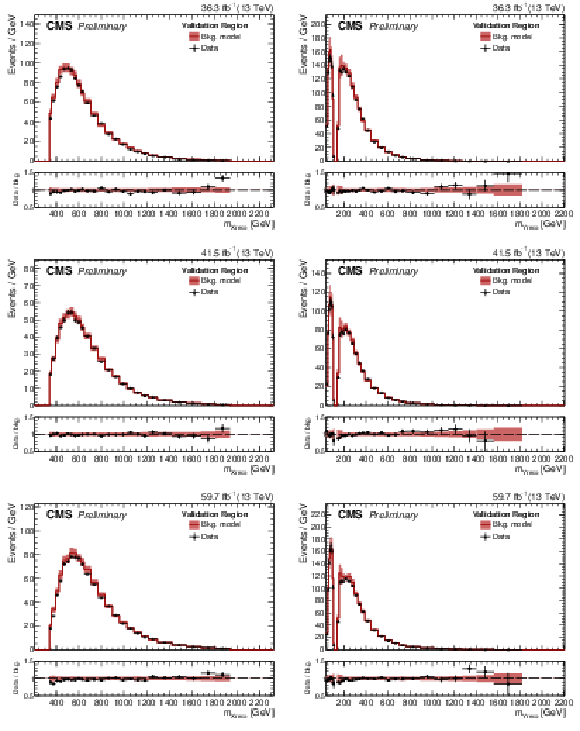
png pdf |
Figure 2:
Event distributions in the validation regions for $\text{m}_{\text{Xreco}}$ (left column) and $ \text{m}_{\text{Yreco}}$ (right column) shown separately for the three data-taking years: 2016, 2017, and 2018 (top, middle, and bottom rows, respectively). The VR(4 b) data is in black and BDT reweighted VR(3 b) model is in red. For $ \text{m}_{\text{Yreco}}$, the VR(3 b) model uncertainty includes the statistical component added in quadrature with the shape, normalization and non-closure uncertainties. For $\text{m}_{\text{Xreco}}$, the VR(3 b) uncertainty includes the statistical, shape, and normalization uncertainties. The ratios of VR(3 b) over SR(4 b) (model over target) are in the lower panels. |

png pdf |
Figure 2-a:
Event distributions in the validation regions for $\text{m}_{\text{Xreco}}$ (left column) and $ \text{m}_{\text{Yreco}}$ (right column) shown separately for the three data-taking years: 2016, 2017, and 2018 (top, middle, and bottom rows, respectively). The VR(4 b) data is in black and BDT reweighted VR(3 b) model is in red. For $ \text{m}_{\text{Yreco}}$, the VR(3 b) model uncertainty includes the statistical component added in quadrature with the shape, normalization and non-closure uncertainties. For $\text{m}_{\text{Xreco}}$, the VR(3 b) uncertainty includes the statistical, shape, and normalization uncertainties. The ratios of VR(3 b) over SR(4 b) (model over target) are in the lower panels. |

png pdf |
Figure 2-b:
Event distributions in the validation regions for $\text{m}_{\text{Xreco}}$ (left column) and $ \text{m}_{\text{Yreco}}$ (right column) shown separately for the three data-taking years: 2016, 2017, and 2018 (top, middle, and bottom rows, respectively). The VR(4 b) data is in black and BDT reweighted VR(3 b) model is in red. For $ \text{m}_{\text{Yreco}}$, the VR(3 b) model uncertainty includes the statistical component added in quadrature with the shape, normalization and non-closure uncertainties. For $\text{m}_{\text{Xreco}}$, the VR(3 b) uncertainty includes the statistical, shape, and normalization uncertainties. The ratios of VR(3 b) over SR(4 b) (model over target) are in the lower panels. |

png pdf |
Figure 2-c:
Event distributions in the validation regions for $\text{m}_{\text{Xreco}}$ (left column) and $ \text{m}_{\text{Yreco}}$ (right column) shown separately for the three data-taking years: 2016, 2017, and 2018 (top, middle, and bottom rows, respectively). The VR(4 b) data is in black and BDT reweighted VR(3 b) model is in red. For $ \text{m}_{\text{Yreco}}$, the VR(3 b) model uncertainty includes the statistical component added in quadrature with the shape, normalization and non-closure uncertainties. For $\text{m}_{\text{Xreco}}$, the VR(3 b) uncertainty includes the statistical, shape, and normalization uncertainties. The ratios of VR(3 b) over SR(4 b) (model over target) are in the lower panels. |

png pdf |
Figure 2-d:
Event distributions in the validation regions for $\text{m}_{\text{Xreco}}$ (left column) and $ \text{m}_{\text{Yreco}}$ (right column) shown separately for the three data-taking years: 2016, 2017, and 2018 (top, middle, and bottom rows, respectively). The VR(4 b) data is in black and BDT reweighted VR(3 b) model is in red. For $ \text{m}_{\text{Yreco}}$, the VR(3 b) model uncertainty includes the statistical component added in quadrature with the shape, normalization and non-closure uncertainties. For $\text{m}_{\text{Xreco}}$, the VR(3 b) uncertainty includes the statistical, shape, and normalization uncertainties. The ratios of VR(3 b) over SR(4 b) (model over target) are in the lower panels. |

png pdf |
Figure 2-e:
Event distributions in the validation regions for $\text{m}_{\text{Xreco}}$ (left column) and $ \text{m}_{\text{Yreco}}$ (right column) shown separately for the three data-taking years: 2016, 2017, and 2018 (top, middle, and bottom rows, respectively). The VR(4 b) data is in black and BDT reweighted VR(3 b) model is in red. For $ \text{m}_{\text{Yreco}}$, the VR(3 b) model uncertainty includes the statistical component added in quadrature with the shape, normalization and non-closure uncertainties. For $\text{m}_{\text{Xreco}}$, the VR(3 b) uncertainty includes the statistical, shape, and normalization uncertainties. The ratios of VR(3 b) over SR(4 b) (model over target) are in the lower panels. |

png pdf |
Figure 2-f:
Event distributions in the validation regions for $\text{m}_{\text{Xreco}}$ (left column) and $ \text{m}_{\text{Yreco}}$ (right column) shown separately for the three data-taking years: 2016, 2017, and 2018 (top, middle, and bottom rows, respectively). The VR(4 b) data is in black and BDT reweighted VR(3 b) model is in red. For $ \text{m}_{\text{Yreco}}$, the VR(3 b) model uncertainty includes the statistical component added in quadrature with the shape, normalization and non-closure uncertainties. For $\text{m}_{\text{Xreco}}$, the VR(3 b) uncertainty includes the statistical, shape, and normalization uncertainties. The ratios of VR(3 b) over SR(4 b) (model over target) are in the lower panels. |

png pdf |
Figure 3:
Event distributions in the signal regions for $\text{m}_{\text{Xreco}}$ (left column) and $ \text{m}_{\text{Yreco}}$ (right column) shown separately for the three data-taking years: 2016, 2017, and 2018 (top, middle, and bottom rows, respectively). The SR(4 b) data is in black and BDT reweighted SR(3 b) model is in red. For $ \text{m}_{\text{Yreco}}$, the SR(3 b) model uncertainty includes the statistical component added in quadrature with the shape, normalization and non-closure uncertainties. For $\text{m}_{\text{Xreco}}$, the SR(3 b) uncertainty includes the statistical, shape, and normalization uncertainties. Three selected signal mass hypotheses are overlaid and show the differences in the shape of the distributions of signals and the background. The signal histograms are scaled to have cross section ($ \sigma $) values of 5 pb. The ratios of SR(3 b) over SR(4 b) (model over target) are in the lower panels. |

png pdf |
Figure 3-a:
Event distributions in the signal regions for $\text{m}_{\text{Xreco}}$ (left column) and $ \text{m}_{\text{Yreco}}$ (right column) shown separately for the three data-taking years: 2016, 2017, and 2018 (top, middle, and bottom rows, respectively). The SR(4 b) data is in black and BDT reweighted SR(3 b) model is in red. For $ \text{m}_{\text{Yreco}}$, the SR(3 b) model uncertainty includes the statistical component added in quadrature with the shape, normalization and non-closure uncertainties. For $\text{m}_{\text{Xreco}}$, the SR(3 b) uncertainty includes the statistical, shape, and normalization uncertainties. Three selected signal mass hypotheses are overlaid and show the differences in the shape of the distributions of signals and the background. The signal histograms are scaled to have cross section ($ \sigma $) values of 5 pb. The ratios of SR(3 b) over SR(4 b) (model over target) are in the lower panels. |

png pdf |
Figure 3-b:
Event distributions in the signal regions for $\text{m}_{\text{Xreco}}$ (left column) and $ \text{m}_{\text{Yreco}}$ (right column) shown separately for the three data-taking years: 2016, 2017, and 2018 (top, middle, and bottom rows, respectively). The SR(4 b) data is in black and BDT reweighted SR(3 b) model is in red. For $ \text{m}_{\text{Yreco}}$, the SR(3 b) model uncertainty includes the statistical component added in quadrature with the shape, normalization and non-closure uncertainties. For $\text{m}_{\text{Xreco}}$, the SR(3 b) uncertainty includes the statistical, shape, and normalization uncertainties. Three selected signal mass hypotheses are overlaid and show the differences in the shape of the distributions of signals and the background. The signal histograms are scaled to have cross section ($ \sigma $) values of 5 pb. The ratios of SR(3 b) over SR(4 b) (model over target) are in the lower panels. |
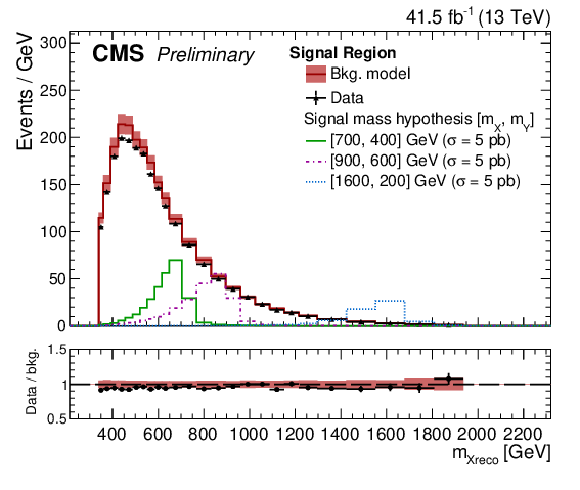
png pdf |
Figure 3-c:
Event distributions in the signal regions for $\text{m}_{\text{Xreco}}$ (left column) and $ \text{m}_{\text{Yreco}}$ (right column) shown separately for the three data-taking years: 2016, 2017, and 2018 (top, middle, and bottom rows, respectively). The SR(4 b) data is in black and BDT reweighted SR(3 b) model is in red. For $ \text{m}_{\text{Yreco}}$, the SR(3 b) model uncertainty includes the statistical component added in quadrature with the shape, normalization and non-closure uncertainties. For $\text{m}_{\text{Xreco}}$, the SR(3 b) uncertainty includes the statistical, shape, and normalization uncertainties. Three selected signal mass hypotheses are overlaid and show the differences in the shape of the distributions of signals and the background. The signal histograms are scaled to have cross section ($ \sigma $) values of 5 pb. The ratios of SR(3 b) over SR(4 b) (model over target) are in the lower panels. |

png pdf |
Figure 3-d:
Event distributions in the signal regions for $\text{m}_{\text{Xreco}}$ (left column) and $ \text{m}_{\text{Yreco}}$ (right column) shown separately for the three data-taking years: 2016, 2017, and 2018 (top, middle, and bottom rows, respectively). The SR(4 b) data is in black and BDT reweighted SR(3 b) model is in red. For $ \text{m}_{\text{Yreco}}$, the SR(3 b) model uncertainty includes the statistical component added in quadrature with the shape, normalization and non-closure uncertainties. For $\text{m}_{\text{Xreco}}$, the SR(3 b) uncertainty includes the statistical, shape, and normalization uncertainties. Three selected signal mass hypotheses are overlaid and show the differences in the shape of the distributions of signals and the background. The signal histograms are scaled to have cross section ($ \sigma $) values of 5 pb. The ratios of SR(3 b) over SR(4 b) (model over target) are in the lower panels. |

png pdf |
Figure 3-e:
Event distributions in the signal regions for $\text{m}_{\text{Xreco}}$ (left column) and $ \text{m}_{\text{Yreco}}$ (right column) shown separately for the three data-taking years: 2016, 2017, and 2018 (top, middle, and bottom rows, respectively). The SR(4 b) data is in black and BDT reweighted SR(3 b) model is in red. For $ \text{m}_{\text{Yreco}}$, the SR(3 b) model uncertainty includes the statistical component added in quadrature with the shape, normalization and non-closure uncertainties. For $\text{m}_{\text{Xreco}}$, the SR(3 b) uncertainty includes the statistical, shape, and normalization uncertainties. Three selected signal mass hypotheses are overlaid and show the differences in the shape of the distributions of signals and the background. The signal histograms are scaled to have cross section ($ \sigma $) values of 5 pb. The ratios of SR(3 b) over SR(4 b) (model over target) are in the lower panels. |

png pdf |
Figure 3-f:
Event distributions in the signal regions for $\text{m}_{\text{Xreco}}$ (left column) and $ \text{m}_{\text{Yreco}}$ (right column) shown separately for the three data-taking years: 2016, 2017, and 2018 (top, middle, and bottom rows, respectively). The SR(4 b) data is in black and BDT reweighted SR(3 b) model is in red. For $ \text{m}_{\text{Yreco}}$, the SR(3 b) model uncertainty includes the statistical component added in quadrature with the shape, normalization and non-closure uncertainties. For $\text{m}_{\text{Xreco}}$, the SR(3 b) uncertainty includes the statistical, shape, and normalization uncertainties. Three selected signal mass hypotheses are overlaid and show the differences in the shape of the distributions of signals and the background. The signal histograms are scaled to have cross section ($ \sigma $) values of 5 pb. The ratios of SR(3 b) over SR(4 b) (model over target) are in the lower panels. |
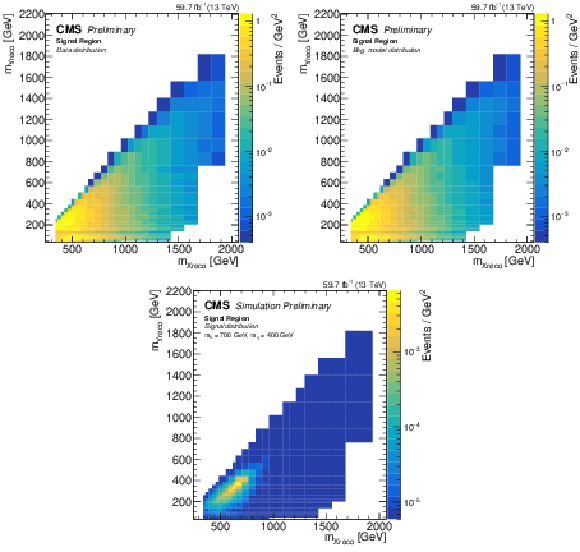
png pdf |
Figure 4:
Distributions of the events in the $ \text{m}_{\text{Xreco}} $ -- $ \text{m}_{\text{Yreco}} $ plane observed in the SR(4 b) in 2018. The top plots show events in data (left) and background model (right). Bottom plot shows distribution of events for the signal hypothesis corresponding to $\text{m}_{\text{X}} = $ 700 GeV and $\text{m}_{\text{Y}} = $ 400 GeV. In each plot, there are empty bins in the high $\text{m}_{\text{Xreco}}$ and low $ \text{m}_{\text{Yreco}}$ region. These areas have been excluded because the events are highly boosted. |

png pdf |
Figure 4-a:
Distributions of the events in the $ \text{m}_{\text{Xreco}} $ -- $ \text{m}_{\text{Yreco}} $ plane observed in the SR(4 b) in 2018. The top plots show events in data (left) and background model (right). Bottom plot shows distribution of events for the signal hypothesis corresponding to $\text{m}_{\text{X}} = $ 700 GeV and $\text{m}_{\text{Y}} = $ 400 GeV. In each plot, there are empty bins in the high $\text{m}_{\text{Xreco}}$ and low $ \text{m}_{\text{Yreco}}$ region. These areas have been excluded because the events are highly boosted. |

png pdf |
Figure 4-b:
Distributions of the events in the $ \text{m}_{\text{Xreco}} $ -- $ \text{m}_{\text{Yreco}} $ plane observed in the SR(4 b) in 2018. The top plots show events in data (left) and background model (right). Bottom plot shows distribution of events for the signal hypothesis corresponding to $\text{m}_{\text{X}} = $ 700 GeV and $\text{m}_{\text{Y}} = $ 400 GeV. In each plot, there are empty bins in the high $\text{m}_{\text{Xreco}}$ and low $ \text{m}_{\text{Yreco}}$ region. These areas have been excluded because the events are highly boosted. |

png pdf |
Figure 4-c:
Distributions of the events in the $ \text{m}_{\text{Xreco}} $ -- $ \text{m}_{\text{Yreco}} $ plane observed in the SR(4 b) in 2018. The top plots show events in data (left) and background model (right). Bottom plot shows distribution of events for the signal hypothesis corresponding to $\text{m}_{\text{X}} = $ 700 GeV and $\text{m}_{\text{Y}} = $ 400 GeV. In each plot, there are empty bins in the high $\text{m}_{\text{Xreco}}$ and low $ \text{m}_{\text{Yreco}}$ region. These areas have been excluded because the events are highly boosted. |
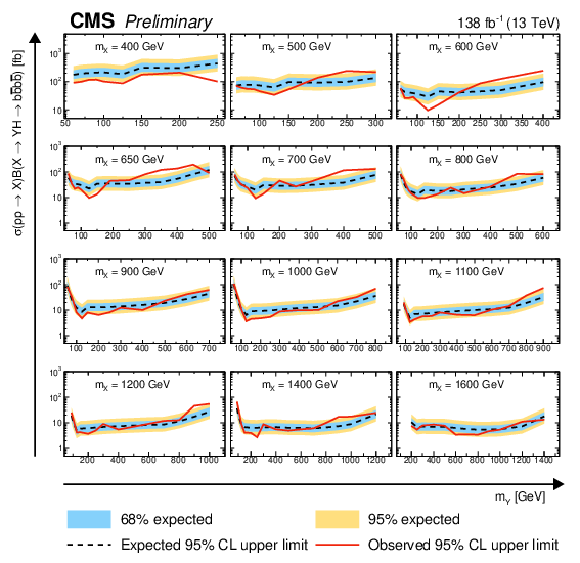
png pdf |
Figure 5:
Expected and observed 95% CL upper limits on the production cross section times branching ratio for $ \text{X} \rightarrow \text{Y} \text{H} $ signal. The limits are shown as a function of $ \text{m}_{\text{Yreco}}$ for selected values of $\text{m}_{\text{Xreco}}$. The black dashed and red solid lines represent expected and observed limits, respectively. The blue and yellow bands represent the $ \pm $1 and $ \pm $2 standard deviations for the expected limit, respectively. The largest excess of the observed limit over the expected limit is for $\text{m}_{\text{Xreco}} = $ 700 GeV and $ \text{m}_{\text{Yreco}} = $ 400 GeV. |

png pdf |
Figure 6:
Expected and observed 95% CL upper limits on the production cross section times branching ratio for $ \XHH $ signal. The black dashed and red solid lines represent expected and observed limits, respectively. The blue and yellow bands represent the $ \pm $1 and $ \pm $2 standard deviations for the expected limit, respectively. |

png pdf |
Figure 7:
Expected and observed 95% CL upper limits on production cross section times branching ratio for $ \text{X} \rightarrow \text{Y} \text{H} $ signals shown in the two-dimensional $\text{m}_{\text{X}}$ and $\text{m}_{\text{Y}}$ plane. These limits are compared to the maximally allowed cross section times branching ratio values determined with NMSSM and taking into account previous experimental constraints. The NMSSM limits are obtained with NMSSMTOOLS 5.6.2 and appear in Ref. [72]. A few mass hypotheses where the observed limits are more restrictive than the NMSSM limits are indicated by the red hatched areas. |
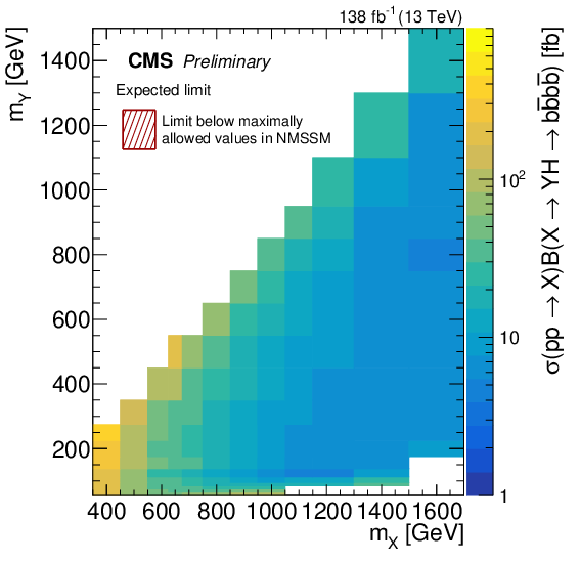
png pdf |
Figure 7-a:
Expected and observed 95% CL upper limits on production cross section times branching ratio for $ \text{X} \rightarrow \text{Y} \text{H} $ signals shown in the two-dimensional $\text{m}_{\text{X}}$ and $\text{m}_{\text{Y}}$ plane. These limits are compared to the maximally allowed cross section times branching ratio values determined with NMSSM and taking into account previous experimental constraints. The NMSSM limits are obtained with NMSSMTOOLS 5.6.2 and appear in Ref. [72]. A few mass hypotheses where the observed limits are more restrictive than the NMSSM limits are indicated by the red hatched areas. |
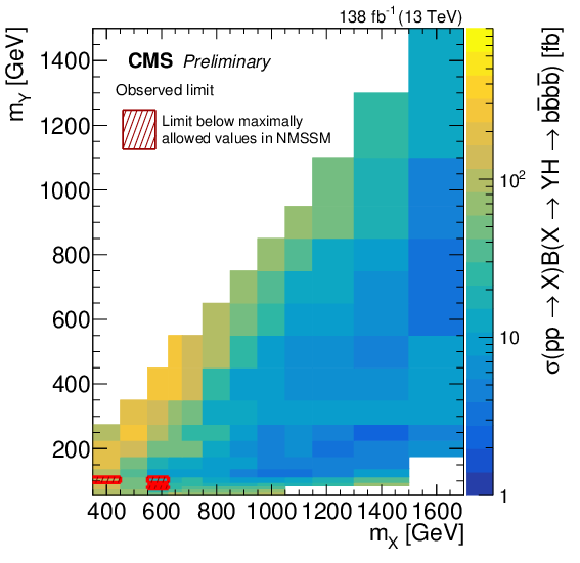
png pdf |
Figure 7-b:
Expected and observed 95% CL upper limits on production cross section times branching ratio for $ \text{X} \rightarrow \text{Y} \text{H} $ signals shown in the two-dimensional $\text{m}_{\text{X}}$ and $\text{m}_{\text{Y}}$ plane. These limits are compared to the maximally allowed cross section times branching ratio values determined with NMSSM and taking into account previous experimental constraints. The NMSSM limits are obtained with NMSSMTOOLS 5.6.2 and appear in Ref. [72]. A few mass hypotheses where the observed limits are more restrictive than the NMSSM limits are indicated by the red hatched areas. |
| Tables | |

png pdf |
Table 1:
The HLT requirements for the lower bounds on $ p_{\mathrm{T}} $ and $ H_{\mathrm{T}} $ for the four highest $ p_{\mathrm{T}} $ jets in an event are listed for each data-taking year. For data-taking year 2016, events that pass either of two trigger algorithms are used. |
| Summary |
| This note presents a search for a new scalar resonance, X, decaying into a Higgs boson and a new scalar, Y, in the four b-quarks decay channel. The search investigates a range of masses from 400 GeV to 1.6 TeV for the resonance, X, and from 60 GeV up to 1.4 TeV for the scalar, Y. A data sample corresponding to an integrated luminosity of 138 fb$^{-1}$ collected in proton-proton collisions at $ \sqrt{s} = $ 13 TeV has been used for the search. No evidence for a new signal is observed and upper limits on the signal cross section times branching ratio are set at the 95% confidence level. Results are interpreted in the context of the NMSSM scenario; the results in this note constrain the phase space of this model beyond previous experimental exclusion limits. |
| References | ||||
| 1 | ATLAS Collaboration | Observation of a new particle in the search for the Standard Model Higgs boson with the ATLAS detector at the LHC | PLB 716 (2012) 1 | 1207.7214 |
| 2 | CMS Collaboration | Observation of a new boson at a mass of 125 GeV with the CMS experiment at the LHC | PLB 716 (2012) 30 | CMS-HIG-12-028 1207.7235 |
| 3 | CMS Collaboration | Observation of a new boson with mass near 125 GeV in pp collisions at $ \sqrt{s} = $ 7 and 8 TeV | JHEP 06 (2013) 081 | CMS-HIG-12-036 1303.4571 |
| 4 | U. Ellwanger, C. Hugonie, and A. M. Teixeira | The Next-to-Minimal Supersymmetric Standard Model | Phys. Rep. 496 (2010) 1 | 0910.1785 |
| 5 | M. Maniatis | The Next-to-Minimal Supersymmetric extension of the Standard Model reviewed | Int. J. Mod. Phys. A 25 (2010) 3505 | 0906.0777 |
| 6 | T. Robens, T. Stefaniak, and J. Wittbrodt | Two-real-scalar-singlet extension of the SM: LHC phenomenology and benchmark scenarios | no.~2, 151, 2020 EPJC 80 (2020) |
1908.08554 |
| 7 | A. Carvalho | Gravity particles from Warped Extra Dimensions, predictions for LHC | 1404.0102 | |
| 8 | U. Ellwanger and M. Rodriguez-Vazquez | Simultaneous search for extra light and heavy Higgs bosons via cascade decays | JHEP 11 (2017) 008 | 1707.08522 |
| 9 | Z. Kang et al. | Probing the CP-even Higgs sector via $ H_3 \rightarrow H_2H_1 $ in the natural next-to-minimal supersymmetric standard model | PRD 88 (2013) 015006 | 1301.0453 |
| 10 | S. F. King, M. Mühlleitner, R. Nevzorov, and K. Walz | Discovery Prospects for NMSSM Higgs Bosons at the High-Energy Large Hadron Collider | PRD 90 (2014) 095014 | 1408.1120 |
| 11 | M. Carena et al. | Alignment limit of the NMSSM Higgs sector | PRD 93 (2016) 035013 | 1510.09137 |
| 12 | U. Ellwanger and M. Rodriguez-Vazquez | Discovery Prospects of a Light Scalar in the NMSSM | JHEP 02 (2016) 096 | 1512.04281 |
| 13 | R. Costa, M. Mühlleitner, M. O. P. Sampaio, and R. Santos | Singlet Extensions of the Standard Model at LHC Run 2: Benchmarks and Comparison with the NMSSM | JHEP 06 (2016) 034 | 1512.05355 |
| 14 | ATLAS Collaboration | Search for a resonance decaying into a scalar particle and a Higgs boson in the final state with two bottom quarks and two photons in proton-proton collisions at a center of mass energy of 13 TeV with the ATLAS detector | Submitted to JHEP, 2024 | 2404.12915 |
| 15 | CMS Collaboration | Search for a new resonance decaying into two spin-0 bosons in a final state with two photons and two bottom quarks in proton-proton collisions at $ \sqrt{s} = $ 13 TeV | JHEP 05 (2024) 316 | CMS-HIG-21-011 2310.01643 |
| 16 | CMS Collaboration | Search for a heavy Higgs boson decaying into two lighter Higgs bosons in the $ \tau\tau $bb final state at 13 TeV | JHEP 11 (2021) 057 | CMS-HIG-20-014 2106.10361 |
| 17 | CMS Collaboration | Search for a massive scalar resonance decaying to a light scalar and a Higgs boson in the four b quarks final state with boosted topology | PLB 842 (2023) 137392 | 2204.12413 |
| 18 | CMS Collaboration | Searches for Higgs Boson Production through Decays of Heavy Resonances | Submitted to Phys. Rep, 2024 | 2403.16926 |
| 19 | C. Csàki, J. Hubisz, and S. J. Lee | Radion phenomenology in realistic warped space models | PRD 76 (2007) 125015 | 0705.3844 |
| 20 | M. Gouzevitch et al. | Scale-invariant resonance tagging in multijet events and new physics in Higgs pair production | JHEP 07 (2013) 148 | 1303.6636 |
| 21 | R. Barbieri et al. | Exploring the Higgs sector of a most natural NMSSM | PRD 87 (2013) 115018 | 1304.3670 |
| 22 | CMS Collaboration | Search for resonant pair production of Higgs bosons decaying to bottom quark-antiquark pairs in proton-proton collisions at 13 TeV | JHEP 08 (2018) 152 | CMS-HIG-17-009 1806.03548 |
| 23 | ATLAS Collaboration | Search for pair production of Higgs bosons in the $ \mathrm{b}\overline{\mathrm{b}}\mathrm{b}\overline{\mathrm{b}} $ final state using proton-proton collisions at $ \sqrt{s} = $ 13 TeV with the ATLAS detector | JHEP 01 (2019) 30 | 1804.06174 |
| 24 | ATLAS Collaboration | Search for resonant pair production of Higgs bosons in the $ b\bar{b}b\bar{b} $ final state using $ pp $ collisions at $ \sqrt{s} = $ 13 TeV with the ATLAS detector | PRD 105 (2022) 092002 | 2202.07288 |
| 25 | CMS Collaboration | Search for Higgs boson pair production in events with two bottom quarks and two tau leptons in proton-proton collisions at $ \sqrt s = $ 13 TeV | PLB 778 (2018) 101 | CMS-HIG-17-002 1707.02909 |
| 26 | ATLAS Collaboration | Combination of searches for heavy resonances decaying into bosonic and leptonic final states using 36 fb$ ^{-1} $ of proton-proton collision data at $ \sqrt{s} = $ 13 TeV with the ATLAS detector | PRD 98 (2018) 052008 | 1808.02380 |
| 27 | CMS Collaboration | Search for Higgs boson pair production in the $ \gamma\gamma\mathrm{b\overline{b}} $ final state in pp collisions at $ \sqrt{s}= $ 13 TeV | PLB 788 (2019) 7 | CMS-HIG-17-008 1806.00408 |
| 28 | CMS Collaboration | Search for resonant and nonresonant Higgs boson pair production in the $ \mathrm{b}\overline{\mathrm{b}}\ell\nu\ell\nu $ final state in proton-proton collisions at $ \sqrt{s}= $ 13 TeV | JHEP 01 (2018) 54 | CMS-HIG-17-006 1708.04188 |
| 29 | CMS Collaboration | Search for resonant pair production of Higgs bosons in the $ bbZZ $ channel in proton-proton collisions at $ \sqrt{s}= $ 13 TeV | PRD 102 (2020) 032003 | CMS-HIG-18-013 2006.06391 |
| 30 | CMS Collaboration | Search for Higgs boson pairs decaying to WW*WW*, WW*$ \tau\tau $, and $ \tau\tau\tau\tau $ in proton-proton collisions at $ \sqrt{s} = $ 13 TeV | JHEP 07 (2023) 095 | CMS-HIG-21-002 2206.10268 |
| 31 | ATLAS Collaboration | Combination of Searches for Resonant Higgs Boson Pair Production Using pp Collisions at $ \sqrt{s} = $ 13 TeV with the ATLAS Detector | PRL 132 (2024) 231801 | 2311.15956 |
| 32 | ATLAS Collaboration | Combination of searches for Higgs boson pair production in $ pp $ collisions at $ \sqrt{s} = $ 13 TeV with the ATLAS detector. | ATLAS-CONF-2024-006, 2024 | |
| 33 | CMS Collaboration | The CMS experiment at the CERN LHC | JINST 3 (2008) S08004 | |
| 34 | CMS Collaboration | Development of the CMS detector for the CERN LHC Run 3 | JINST 19 (2024) P05064 | CMS-PRF-21-001 2309.05466 |
| 35 | CMS Collaboration | Performance of the CMS Level-1 trigger in proton-proton collisions at $ \sqrt{s} = $ 13 TeV | JINST 15 (2020) P10017 | CMS-TRG-17-001 2006.10165 |
| 36 | CMS Collaboration | The CMS trigger system | JINST 12 (2017) P01020 | CMS-TRG-12-001 1609.02366 |
| 37 | CMS Collaboration | Electron and photon reconstruction and identification with the CMS experiment at the CERN LHC | JINST 16 (2021) P05014 | CMS-EGM-17-001 2012.06888 |
| 38 | CMS Collaboration | Performance of the CMS muon detector and muon reconstruction with proton-proton collisions at $ \sqrt{s}= $ 13 TeV | JINST 13 (2018) P06015 | CMS-MUO-16-001 1804.04528 |
| 39 | CMS Collaboration | Description and performance of track and primary-vertex reconstruction with the CMS tracker | JINST 9 (2014) P10009 | CMS-TRK-11-001 1405.6569 |
| 40 | CMS Collaboration | Particle-flow reconstruction and global event description with the CMS detector | JINST 12 (2017) P10003 | CMS-PRF-14-001 1706.04965 |
| 41 | CMS Collaboration | Performance of reconstruction and identification of $ \tau $ leptons decaying to hadrons and $ \nu_\tau $ in pp collisions at $ \sqrt{s}= $ 13 TeV | JINST 13 (2018) P10005 | CMS-TAU-16-003 1809.02816 |
| 42 | CMS Collaboration | Jet energy scale and resolution in the CMS experiment in pp collisions at 8 TeV | JINST 12 (2017) P02014 | CMS-JME-13-004 1607.03663 |
| 43 | CMS Collaboration | Performance of missing transverse momentum reconstruction in proton-proton collisions at $ \sqrt{s} = $ 13 TeV using the CMS detector | JINST 14 (2019) P07004 | CMS-JME-17-001 1903.06078 |
| 44 | M. Cacciari, G. P. Salam, and G. Soyez | The anti-$ k_{\mathrm{T}} $ jet clustering algorithm | JHEP 04 (2008) 063 | 0802.1189 |
| 45 | M. Cacciari, G. P. Salam, and G. Soyez | FastJet user manual | EPJC 72 (2012) 1896 | 1111.6097 |
| 46 | E. Bols et al. | Jet Flavour Classification Using DeepJet | JINST 15 (2020) P12012 | 2008.10519 |
| 47 | CMS Collaboration | Identification of heavy-flavour jets with the CMS detector in pp collisions at 13 TeV | JINST 13 (2018) P05011 | CMS-BTV-16-002 1712.07158 |
| 48 | J. Alwall et al. | The automated computation of tree-level and next-to-leading order differential cross sections, and their matching to parton shower simulations | JHEP 07 (2014) 079 | 1405.0301 |
| 49 | NNPDF Collaboration | Parton distributions for the LHC Run II | JHEP 04 (2015) 040 | 1410.8849 |
| 50 | S. Alioli, P. Nason, C. Oleari, and E. Re | NLO vector-boson production matched with shower in POWHEG | JHEP 07 (2008) 060 | 0805.4802 |
| 51 | P. Nason | A New method for combining NLO QCD with shower Monte Carlo algorithms | JHEP 11 (2004) 040 | hep-ph/0409146 |
| 52 | M. Czakon and A. Mitov | Top++: A Program for the Calculation of the Top-Pair Cross-Section at Hadron Colliders | Comput. Phys. Commun. 185 (2014) 2930 | 1112.5675 |
| 53 | J. M. Campbell, R. K. Ellis, and C. Williams | Vector boson pair production at the LHC | JHEP 07 (2011) 018 | 1105.0020 |
| 54 | T. Sjöstrand et al. | An introduction to PYTHIA 8.2 | Comput. Phys. Commun. 191 (2015) 159 | 1410.3012 |
| 55 | GEANT4 Collaboration | GEANT 4--a simulation toolkit | NIM A 506 (2003) 250 | |
| 56 | CMS Collaboration | Jet algorithms performance in 13 TeV data | Technical Report, CERN, Geneva, 2017 CMS-PAS-JME-16-003 |
CMS-PAS-JME-16-003 |
| 57 | CMS Collaboration | Pileup mitigation at CMS in 13 TeV data | JINST 15 (2020) P09018 | CMS-JME-18-001 2003.00503 |
| 58 | CMS Collaboration | A Deep Neural Network for Simultaneous Estimation of b Jet Energy and Resolution | Comput. Softw. Big Sci. 4 (2020) 10 | CMS-HIG-18-027 1912.06046 |
| 59 | A. Rogozhnikov | Reweighting with Boosted Decision Trees | J. Phys. Conf. Ser. 762 (2016) 012036 | 1608.05806 |
| 60 | Chakravarti, Laha, and Roy | Handbook of Methods of Applied Statistics, Volume I | John Wiley and Sons, 1967 | |
| 61 | CMS Collaboration | Search for Higgs Boson Pair Production in the Four b Quark Final State in Proton-Proton Collisions at $ \sqrt{s} = $ 13 TeV | PRL 129 (2022) 081802 | CMS-HIG-20-005 2202.09617 |
| 62 | CMS Collaboration | Precision luminosity measurement in proton-proton collisions at $ \sqrt{s} = $ 13 TeV in 2015 and 2016 at CMS | EPJC 81 (2021) 800 | CMS-LUM-17-003 2104.01927 |
| 63 | CMS Collaboration | CMS luminosity measurement for the 2017 data-taking period at $ \sqrt{s} = $ 13 TeV | CMS Physics Analysis Summary, 2018 link |
CMS-PAS-LUM-17-004 |
| 64 | CMS Collaboration | CMS luminosity measurement for the 2018 data-taking period at $ \sqrt{s} = $ 13 TeV | CMS Physics Analysis Summary, 2019 link |
CMS-PAS-LUM-18-002 |
| 65 | CMS Collaboration | The CMS statistical analysis and combination tool: Combine | Submitted to Comput. Softw. Big Sci, 2024 | CMS-CAT-23-001 2404.06614 |
| 66 | W. Verkerke and D. P. Kirkby | The RooFit toolkit for data modeling | eConf C0303241 MOLT007, 2003 | physics/0306116 |
| 67 | L. Moneta et al. | The RooStats Project | PoS ACAT 057, 2010 link |
1009.1003 |
| 68 | T. Junk | Confidence level computation for combining searches with small statistics | NIM A 434 (1999) 435 | hep-ex/9902006 |
| 69 | A. L. Read | Presentation of search results: the $ CL_s $ technique | JPG 28 (2002) 2693 | |
| 70 | E. Gross and O. Vitells | Trial factors for the look elsewhere effect in high energy physics | EPJC 70 (2010) 525 | 1005.1891 |
| 71 | O. Vitells and E. Gross | Estimating the significance of a signal in a multi-dimensional search | Astroparticle Physics 35 (2011) 230 | 1105.4355 |
| 72 | U. Ellwanger and C. Hugonie | Benchmark planes for Higgs-to-Higgs decays in the NMSSM | EPJC 82 (2022) 406 | 2203.05049 |

|
Compact Muon Solenoid LHC, CERN |

|

|

|

|

|

|